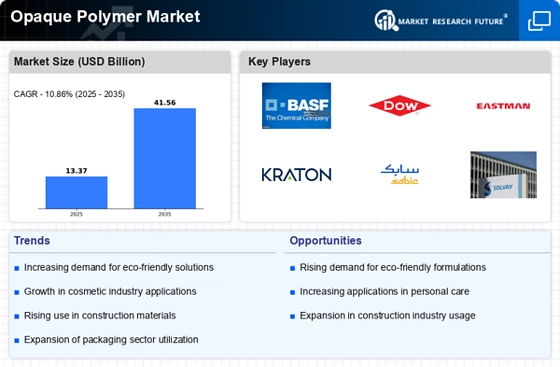Rising Demand in Coatings and Paints
The Opaque Polymer Market experiences a notable surge in demand from the coatings and paints sector. This growth is primarily driven by the increasing need for high-performance coatings that offer superior opacity and durability. As manufacturers seek to enhance product quality, opaque polymers are increasingly utilized to improve the aesthetic appeal and functional properties of coatings. Recent data indicates that the coatings segment accounts for a substantial share of the overall market, with projections suggesting a compound annual growth rate of approximately 5% over the next few years. This trend underscores the importance of opaque polymers in meeting the evolving requirements of the coatings industry, thereby solidifying their role in the Opaque Polymer Market.
Expansion in the Personal Care Sector
The Opaque Polymer Market is witnessing significant growth due to the expanding applications in the personal care sector. Opaque polymers are increasingly incorporated into cosmetic formulations, such as foundations and creams, to enhance texture and provide a desirable finish. The rising consumer preference for products that offer a natural appearance and feel has led to a greater demand for opaque polymers, which can effectively improve product performance. Market analysis reveals that the personal care segment is projected to grow at a rate of around 6% annually, reflecting the increasing integration of opaque polymers in various cosmetic products. This trend highlights the pivotal role of opaque polymers in the Opaque Polymer Market, catering to the evolving needs of consumers.
Innovations in Manufacturing Processes
The Opaque Polymer Market is experiencing a transformation driven by innovations in manufacturing processes. Advances in polymerization techniques and formulation technologies are enabling the production of more efficient and effective opaque polymers. These innovations not only enhance the performance of the polymers but also contribute to cost reductions in manufacturing. As companies strive to improve product quality while minimizing environmental impact, the adoption of sustainable manufacturing practices is becoming increasingly prevalent. This shift is likely to bolster the competitive landscape of the Opaque Polymer Market, as manufacturers leverage these advancements to meet the growing demand for high-performance products.
Growth in the Adhesives and Sealants Market
The Opaque Polymer Market is significantly influenced by the growth in the adhesives and sealants market. As industries seek to enhance bonding strength and durability, opaque polymers are increasingly utilized to improve the performance characteristics of adhesives. The demand for high-quality adhesives in construction, automotive, and packaging applications is on the rise, with the adhesives segment expected to grow at a compound annual growth rate of approximately 4.5% in the coming years. This growth is indicative of the expanding applications of opaque polymers, which are essential for achieving desired performance attributes in various adhesive formulations. Consequently, the Opaque Polymer Market is poised to benefit from this upward trend.
Increasing Regulatory Compliance and Standards
The Opaque Polymer Market is also shaped by the increasing regulatory compliance and standards imposed on various industries. As environmental concerns gain prominence, regulations regarding the use of certain chemicals in products are becoming more stringent. This has led manufacturers to seek alternatives that comply with these regulations while maintaining product efficacy. Opaque polymers, known for their versatility and safety, are emerging as a preferred choice in formulations across multiple sectors. The need for compliance with evolving standards is expected to drive the demand for opaque polymers, thereby influencing the growth trajectory of the Opaque Polymer Market in the foreseeable future.

















Leave a Comment